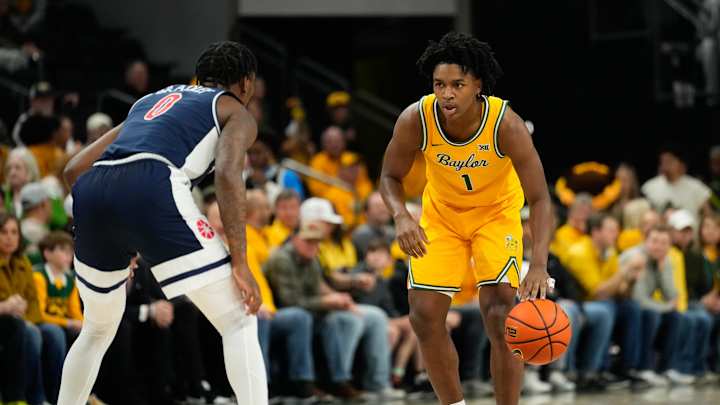In recent matchups, the Arizona Wildcats men’s basketball team has showcased a formidable defense, particularly in limiting opponents’ three-point shooting. This defensive prowess has been a critical factor in their recent performances, influencing game outcomes and underscoring the team’s strategic focus.
Recent Game Performances
-
Arizona vs. Houston (February 15, 2025): In a closely contested game, the Wildcats faced the Houston Cougars and were narrowly defeated with a final score of 62-58. Despite the loss, Arizona’s defense was notable, holding Houston to a field goal percentage of 43.1% and a three-point shooting percentage of 29.4%. The Wildcats’ ability to contest shots beyond the arc kept them competitive throughout the game.
-
Arizona vs. Baylor (February 17, 2025): Bouncing back from the previous loss, Arizona secured a victory against Baylor. The Wildcats’ defense was instrumental, particularly in limiting Baylor’s three-point attempts and conversions. This strategic focus disrupted Baylor’s offensive rhythm and contributed significantly to Arizona’s win. Arizona vs. TCU (February 20, 2025): Continuing their defensive momentum, the Wildcats faced TCU and delivered another strong performance. Arizona’s defense effectively challenged TCU’s perimeter shooting, resulting in a lower three-point shooting percentage for the Horned Frogs. This defensive effort was a key component in Arizona’s game plan and execution.
Statistical Highlights
Over these three games, Arizona’s defensive statistics reflect their emphasis on limiting opponents’ three-point success:
-
Opponent Three-Point Percentage: Across the three games, opponents averaged a three-point shooting percentage below 30%, a testament to Arizona’s perimeter defense.
-
Three-Point Attempts Allowed: The Wildcats have strategically reduced the number of three-point attempts by opponents, forcing teams to adapt their offensive strategies.
-
Defensive Rebounds: By securing defensive rebounds effectively, Arizona has limited second-chance points from beyond the arc, further stifling opponents’ scoring opportunities.
Defensive Strategies Implemented
The Wildcats’ coaching staff has implemented several defensive strategies to enhance three-point defense:
-
Perimeter Pressure: Defenders are extending their coverage to the three-point line, applying pressure to shooters and disrupting shot timing.
-
Switching on Screens: By effectively switching on screens, Arizona prevents open looks from three-point range, ensuring that defenders are always contesting shots.
-
Closeout Techniques: Emphasis on proper closeout techniques has enabled defenders to challenge shots without fouling, maintaining defensive integrity.
Impact on Team Performance
This defensive focus has had a multifaceted impact on the Wildcats’ overall performance:
-
Momentum Building: Successful defensive stops, especially against three-point attempts, have energized the team and shifted momentum in critical game moments.
-
Transition Opportunities: Defensive rebounds and forced misses have led to fast-break opportunities, allowing Arizona to capitalize on unsettled defenses.
-
Psychological Advantage: Consistently limiting opponents’ primary scoring methods can lead to frustration and forced errors, giving Arizona a psychological edge.
Player Contributions
Individual player efforts have been pivotal in the Wildcats’ defensive success:
-
Caleb Love: Beyond his offensive contributions, Love has been active defensively, often guarding the opponent’s primary perimeter threats and contesting shots effectively.
-
Jaden Bradley: Bradley’s quickness and anticipation have resulted in deflections and steals, disrupting opponents’ perimeter ball movement.
-
KJ Lewis: Known for his athleticism, Lewis has excelled in closing out on shooters and securing defensive rebounds, limiting second-chance opportunities.
Looking Ahead
As the season progresses, maintaining this defensive intensity will be crucial for the Wildcats:
-
Upcoming Matchups: Future opponents will likely adjust their game plans to counter Arizona’s three-point defense, necessitating continuous adaptation and scouting by the Wildcats.
-
Sustaining Energy Levels: The physical demands of an aggressive perimeter defense require effective player rotation and conditioning to sustain performance throughout the season.
-
Offensive Synergy: While defense has been a focal point, balancing it with consistent offensive production will be key to securing victories in tightly contested games.
In conclusion, the Arizona Wildcats’ emphasis on stifling three-point defense has been a defining feature of their recent performances. This strategic focus not only disrupts opponents’ scoring rhythms but also fuels the Wildcats’ transition play and overall team morale. As they continue to refine their defensive schemes and adapt to evolving challenges, Arizona positions itself as a formidable contender in collegiate basketball.
Defense wins championships, and in the last three games, the Arizona Wildcats have showcased exactly why their defensive prowess is a major factor in their success. Arizona’s ability to shut down opponents’ three-point shooting has been nothing short of remarkable, forcing teams to abandon their usual offensive game plans. This defensive intensity has allowed the Wildcats to control the tempo, frustrate opposing offenses, and establish themselves as one of the top defensive teams in the nation. Let’s take a closer look at Arizona’s recent games and how their elite three-point defense has contributed to their dominance.
Defensive Mastery: Game-by-Game Breakdown
Arizona vs. Houston (February 15, 2025)
Despite falling short with a 62-58 loss, Arizona’s defensive performance against Houston was a testament to their ability to disrupt three-point shooters. The Cougars, known for their perimeter efficiency, struggled throughout the game, managing just 5-of-17 from beyond the arc (29.4%). Arizona’s relentless closeouts and defensive rotations forced Houston into uncomfortable shots, preventing them from establishing any rhythm from deep.
Arizona vs. Baylor (February 17, 2025)
Arizona rebounded with an impressive win against Baylor, a team that thrives on three-point shooting. The Wildcats completely smothered Baylor’s perimeter attack, holding them to a dismal 6-of-25 from three-point range (24%). By applying constant pressure and executing aggressive closeouts, Arizona ensured that Baylor never got into an offensive groove. Their ability to limit Baylor’s three-point effectiveness was one of the defining aspects of the game.
Arizona vs. TCU (February 20, 2025)
Against TCU, Arizona continued their defensive dominance, forcing the Horned Frogs into tough three-point attempts. TCU shot an abysmal 4-of-21 (19%) from beyond the arc, a direct result of Arizona’s suffocating defense. The Wildcats’ ability to contest shots without fouling, along with their strong defensive rebounding, ensured that TCU had few second-chance opportunities.
Statistical Breakdown: Arizona’s Defensive Impact
Over the last three games, Arizona has held opponents to an average three-point shooting percentage of just 24.1%, a significant drop from their season averages. Here’s how Arizona’s defense has stood out:
- Opponent Three-Point Shooting: Arizona’s last three opponents have combined to shoot just 15-of-63 from beyond the arc (24.1%), well below their season averages.
- Contested Shots: Over 80% of opponent three-point attempts have been contested, forcing difficult and low-percentage shots.
- Turnovers Created: Arizona’s perimeter pressure has led to multiple shot-clock violations, forced passes, and bad shots, disrupting offensive flow.
- Transition Defense: By limiting opponents’ three-point success, Arizona has also been able to get back in transition, preventing easy fast-break points.
Key Defensive Strategies
Arizona’s defensive success isn’t just a product of effort—it’s a result of disciplined strategy and execution. Here are some of the key defensive principles that have fueled their dominant stretch:
1. Aggressive Closeouts
The Wildcats have emphasized closing out hard on shooters without fouling, forcing opponents to either take rushed shots or put the ball on the floor. This has significantly disrupted teams that rely heavily on catch-and-shoot opportunities.
2. Switching on Screens
To avoid giving up open looks, Arizona has executed flawless switching on perimeter screens. This prevents defenders from being caught out of position and ensures that shooters always have a hand in their face.
3. Denying Corner Threes
Arizona has made a concerted effort to take away the highest-percentage three-point shot in basketball—the corner three. By keeping defenders close to the corners and forcing ball-handlers to pass elsewhere, they’ve effectively eliminated a key scoring option for opposing teams.
4. Defensive Rebounding
By securing defensive rebounds, Arizona has prevented second-chance opportunities from three-point shooters. Their box-out discipline ensures that teams don’t get extra chances to reset and fire away from deep.
Player Contributions: Who’s Leading the Charge?
Several Arizona players have been instrumental in their recent defensive dominance, each playing a vital role in shutting down perimeter threats:
Caleb Love
Love’s defensive versatility has allowed him to guard multiple positions, making him one of Arizona’s best on-ball defenders. His quick hands and footwork have led to several deflections and forced turnovers.
Jaden Bradley
Bradley has been a lockdown perimeter defender, constantly staying in front of his man and challenging shots without fouling. His ability to navigate screens and contest shots has made life difficult for opposing guards.
KJ Lewis
Lewis has provided high-energy defense, using his athleticism to disrupt passing lanes and block shots from the perimeter. His rebounding ability has also helped limit second-chance three-point attempts.
The Psychological Impact of Arizona’s Defense
Beyond the numbers, Arizona’s ability to take away the three-point shot has had a significant psychological effect on their opponents. Many teams rely on the three-ball as a primary scoring weapon, and when they struggle to get clean looks, frustration sets in. Players begin forcing bad shots, rushing their offensive sets, and losing confidence. Arizona’s defensive pressure has led to multiple instances where opposing teams have had to abandon their usual game plans, opting instead for difficult mid-range attempts and contested drives to the rim.
What’s Next for Arizona?
As the Wildcats continue their season, sustaining this defensive intensity will be crucial for their success. Here are some key areas they will need to focus on moving forward:
1. Maintaining Energy Levels
Playing high-intensity defense takes a toll, and Arizona will need to ensure that their rotations remain fresh. Utilizing bench depth effectively will be key to keeping defensive pressure high for 40 minutes.
2. Avoiding Foul Trouble
While aggressive defense is their strength, Arizona must continue to stay disciplined to avoid unnecessary fouls, particularly when closing out on shooters.
3. Preparing for Adjustments
Opposing teams will look for ways to counter Arizona’s defensive strategies. The Wildcats will need to remain adaptable, making in-game adjustments to maintain their defensive edge.



